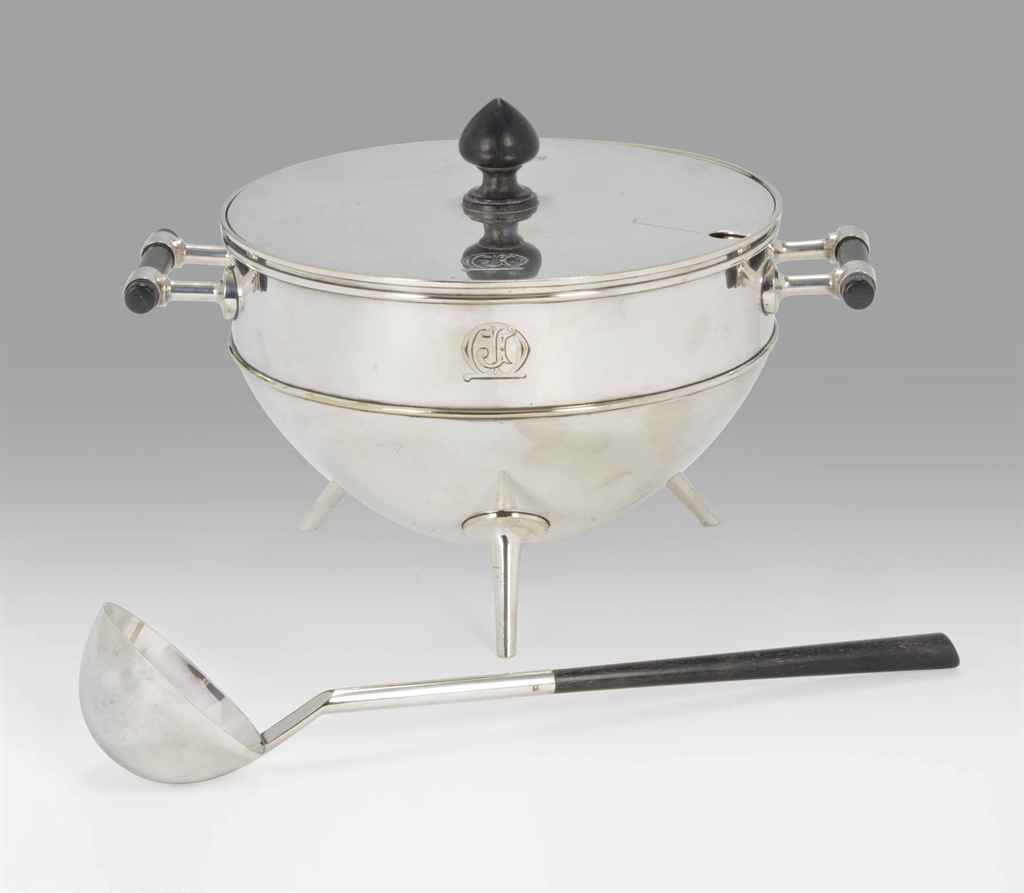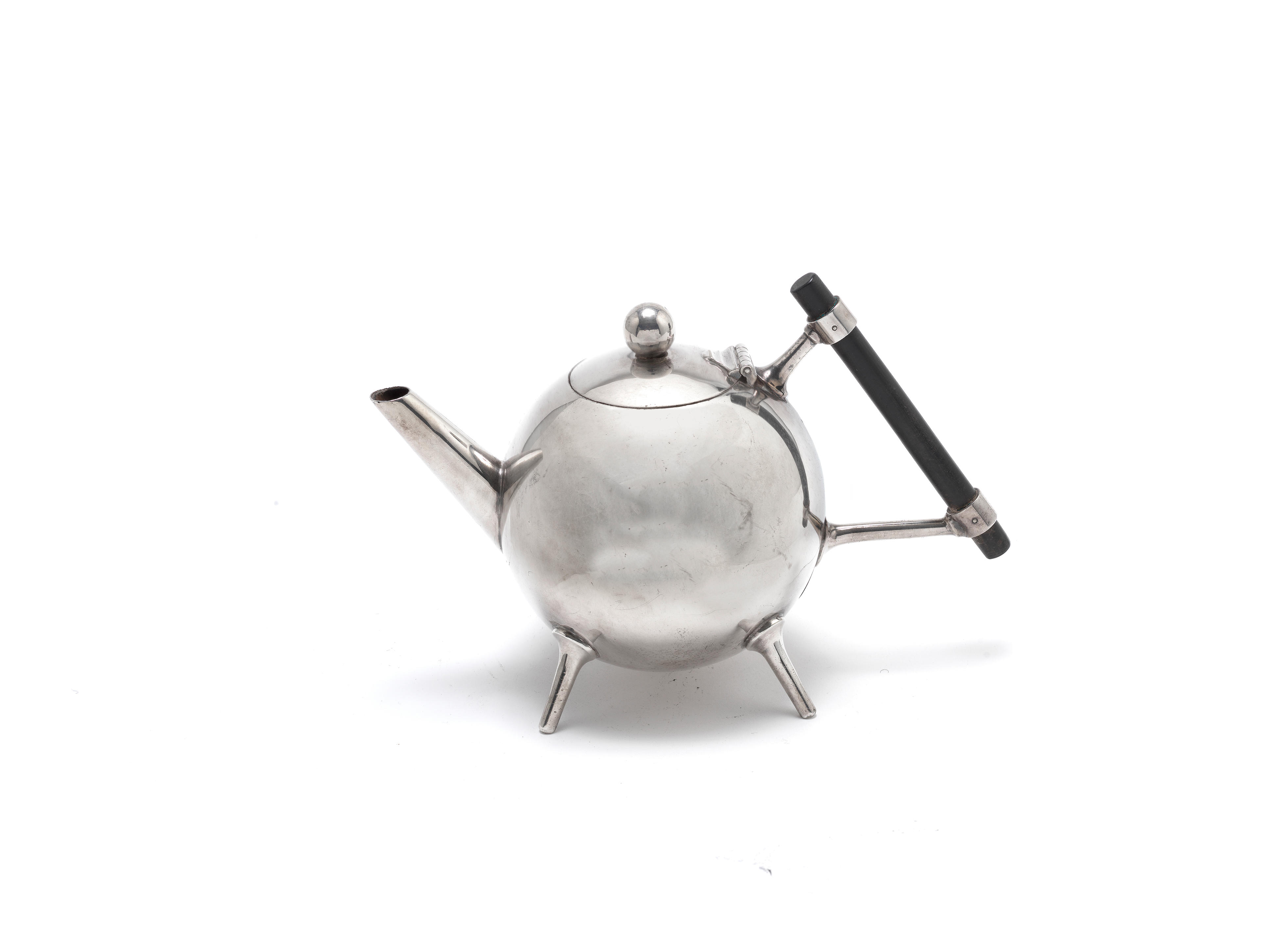Dr. Christopher Dresser Important display cabinet circa 1880 Ebonized wood, copper with inset cloisonné enamel. 65 3/4 x 47 7/8 x 14 3/4 in. (167 x 121.6 x 37.5 cm)
Catalogue Essay The use of bold idiosyncratic pigeon holes is a signature motif found on the very few Dr. Christopher Dresser display cabinets which have been identified to date. This example with its emphatic run of nine arched niches is perhaps the boldest. (See Jeremy Cooper, Victorian and Edwardian Furniture and Interiors, London, 1987, pl. 359 for a larger version now in the Carnegie Museum of Art, Women’s Committee Acquisition Fund, 2002. A more elaborate example is in the Birkenhead collection, London.) The most striking feature of the present lot, apart from the distinctive Dresser pigeon holes, are the pair of Japanese copper door panels which are inset with cloisonné enamel and delicately engraved and worked in high relief. The use of ornamented copper in such a severe and daring manner demonstrates an originality and willfulness that is characteristic of Dresser’s work. Two of Dresser’s illustrations titled “Japanese Ornaments" appear in The British Architect in January and February 1879 and provide convincing evidence of Dresser’s contemporary use and approval of such ornaments. They are also helpful in dating: the arrangement of the designs is also similar to the panels of the present cabinet. The suggestion is further supported by the advertisement of Dresser’s import company Dresser & Home of Christmas 1880, in The Furniture Gazette (of which he was also editor) which lists Japanese items including “enamels transparent and opaque” and “panels for furniture.” (Dresser encouraged and promoted the incorporation of Japanese and oriental details into English manufactured goods not only because of the excellence of workmanship but despite the many advances in manufacturing techniques, e.g. cloisonné enamels by Elkington & Co, and despite transport halfway round the globe, the imported goods still proved to be cheaper and were unsurpassed in their quality and beauty.) In the introduction to The Dresser Collection of Japanese Curios and Articles selected for Messrs Tiffany & Co., Dresser is described as “late of South Kensington, London, whose reputation as an authority and experience as a collector is a guarantee of the excellence of the collection,” which contained many examples of cloisonné collected by Dresser in Japan during his visit in 1876-1877. Finally,one of the few other examples of Victorian furniture to utilize Japanese cloisonné panels as the primary means of ornamentation is the ebonized cabinet, illustrated as item No 19, p.23, “125 Years 1876-2001,” The Fine Arts Society PLC, of a form now known to be by Jackson and Graham the pre-eminent cabinet makers of the period for whom Dresser designed as early as 1858. Christopher Morley, November 2013 Author of Dresser’s Decorative Design, 2010 Phillips would like to thank Christopher Morley for his assistance cataloguing this lot. Read More
Dr. Christopher Dresser Important display cabinet circa 1880 Ebonized wood, copper with inset cloisonné enamel. 65 3/4 x 47 7/8 x 14 3/4 in. (167 x 121.6 x 37.5 cm)
Catalogue Essay The use of bold idiosyncratic pigeon holes is a signature motif found on the very few Dr. Christopher Dresser display cabinets which have been identified to date. This example with its emphatic run of nine arched niches is perhaps the boldest. (See Jeremy Cooper, Victorian and Edwardian Furniture and Interiors, London, 1987, pl. 359 for a larger version now in the Carnegie Museum of Art, Women’s Committee Acquisition Fund, 2002. A more elaborate example is in the Birkenhead collection, London.) The most striking feature of the present lot, apart from the distinctive Dresser pigeon holes, are the pair of Japanese copper door panels which are inset with cloisonné enamel and delicately engraved and worked in high relief. The use of ornamented copper in such a severe and daring manner demonstrates an originality and willfulness that is characteristic of Dresser’s work. Two of Dresser’s illustrations titled “Japanese Ornaments" appear in The British Architect in January and February 1879 and provide convincing evidence of Dresser’s contemporary use and approval of such ornaments. They are also helpful in dating: the arrangement of the designs is also similar to the panels of the present cabinet. The suggestion is further supported by the advertisement of Dresser’s import company Dresser & Home of Christmas 1880, in The Furniture Gazette (of which he was also editor) which lists Japanese items including “enamels transparent and opaque” and “panels for furniture.” (Dresser encouraged and promoted the incorporation of Japanese and oriental details into English manufactured goods not only because of the excellence of workmanship but despite the many advances in manufacturing techniques, e.g. cloisonné enamels by Elkington & Co, and despite transport halfway round the globe, the imported goods still proved to be cheaper and were unsurpassed in their quality and beauty.) In the introduction to The Dresser Collection of Japanese Curios and Articles selected for Messrs Tiffany & Co., Dresser is described as “late of South Kensington, London, whose reputation as an authority and experience as a collector is a guarantee of the excellence of the collection,” which contained many examples of cloisonné collected by Dresser in Japan during his visit in 1876-1877. Finally,one of the few other examples of Victorian furniture to utilize Japanese cloisonné panels as the primary means of ornamentation is the ebonized cabinet, illustrated as item No 19, p.23, “125 Years 1876-2001,” The Fine Arts Society PLC, of a form now known to be by Jackson and Graham the pre-eminent cabinet makers of the period for whom Dresser designed as early as 1858. Christopher Morley, November 2013 Author of Dresser’s Decorative Design, 2010 Phillips would like to thank Christopher Morley for his assistance cataloguing this lot. Read More















Testen Sie LotSearch und seine Premium-Features 7 Tage - ohne Kosten!
Lassen Sie sich automatisch über neue Objekte in kommenden Auktionen benachrichtigen.
Suchauftrag anlegen